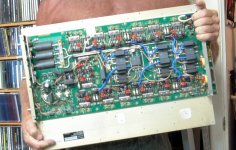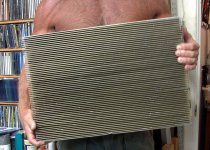"Road Runner"
The Road Runner was the name the Plymouth division of Chrysler assigned to its muscle car from 1968 to somewhere in the mid 70's. The name comes from the Warner Brothers cartoon series that featured Wylie Coyote and the infamous ACME catalog. The cartoon bird is featured somewhere on the car.
The car shown in the black and white picture in post #16 is a 1973 Road Runner. It had a Collins linear amp where the back seat should have been, and a trunk full of batteries. The cartoon bird is the white (yellow) spot in the vertical portion of the black stripe. The car was actually yellow and black.
I think I may give solid state a try in the future. I've got an HP 48VDC 3kw SMPS to power it.
The older MRI amplifiers ran MFR150 transistors and put out up to 2 KW on 13.56 MHz. Many of the amps were broadband enough to cover 40 through 10. Each MRF150 can make up to 150 watts and there were circuits and PCB's all over the web running from one to 4 of them. These amps were being replaced by newer amps 5 to 10 years ago and pullouts could be found cheap. I grabbed several at the Dayton hamfest over the years for $50 each or less. Some had as many as 24 transistors on them.
I picked up one of the newer versions a few years ago. It was dead, but cheap. I mined it for the parts, then resold the heat sink to a class A audio guy for more than I paid for the dead amp. Picture shows the new amp before disassembly. I think it was a 5KW amp.
Attachments
Crikey. Haven't been to Dayton or Zenia I guess for a couple years. I moved a while back and it seems I never have time for much.
I see you're near Moundsville. I have an uncle that spent some time there. His movement was a bit restricted. I remember visiting him when I was a kid. I'll keep watch for the ss rf amps. Would be a good start on a project.
There's a fellow in eastern europe that makes all the bits less the semiconductors to make a nice linear. Even has bandswitching filters to keep the neighbors happy. Aftermarket legal limit SS amps range from 7 to 10 thousand dollars. A little out of my league.
I see you're near Moundsville. I have an uncle that spent some time there. His movement was a bit restricted. I remember visiting him when I was a kid. I'll keep watch for the ss rf amps. Would be a good start on a project.
There's a fellow in eastern europe that makes all the bits less the semiconductors to make a nice linear. Even has bandswitching filters to keep the neighbors happy. Aftermarket legal limit SS amps range from 7 to 10 thousand dollars. A little out of my league.
7094 in SE A1:
300V G2 will do
500V 200mA 2.5K
700V 140mA 5K
1000V 100mA 10K
All can be trimmed for about 40W output.
It's not real linear in SE. P-P makes lots more sense, IF you need 400+ Watts (clearly described in the data sheet as "audio").
How about P-P operating point with 1800V B+?
That's what my present PS is rated for. This is also the B+ that the tubes
were running at in the linear amplifier.
I may have other power transformers with lower V out but need to check
them.
I have a hefty power transformer as an output transformer candidate.
I'm thinking regulated 300V on the screens and maybe EL34 cathode
followers driving the grids?
If I proceed with this it will be a subwoofer amp as George suggested.
Thanks!
Tube data:
https://www.w8ji.com/images/Amplifier/7094.pdf
I've read articles that said that the 7094 was intended to be a modernized and modest-sized update of an 813 equivalent. I have also read that unlike the pretty much bulletproof 813, the 7094s are infamously fragile and short lived in the face of abuse or even full-intensity ordinary use. There was a Hallicrafters HF linear amp that used them, the HT-41, and its main claim to fame is usually being found in entirely kaput condition, mainly but maybe not only because of the tubes.
I read up to this extent on the 7094s because when I first ran across a spec for them, they looked like a cool combination of a lot of plate dissipation, a common/easy 6.3v filament, in a compact package, and my mind turned to homebrew applications. As I began to look into them my interest waned really quickly. If I had some I would try to sell them to some hapless soul needing them for an HT-41, and I'd put the proceeds to a different tube.
I read up to this extent on the 7094s because when I first ran across a spec for them, they looked like a cool combination of a lot of plate dissipation, a common/easy 6.3v filament, in a compact package, and my mind turned to homebrew applications. As I began to look into them my interest waned really quickly. If I had some I would try to sell them to some hapless soul needing them for an HT-41, and I'd put the proceeds to a different tube.
I have an HT-41. It's pretty much a basket case hence the 1800V ps.
I may throw the tubes on ebay or something then.
I may throw the tubes on ebay or something then.
The real Achilles heal of the 7094 is the cathode connecting link at the bottom of the structure. This link is a thin strip of metal that connects to the pin and acts like a fuse if the tube is ever badly overloaded or red plated. You can sometimes see if it's broken by looking with a magnifying glass assuming the getter flash isn't in the way.
I've got several nos tubes. Was thinking I could run them gently and get a decent
lifespan from them.
lifespan from them.
- Home
- Amplifiers
- Tubes / Valves
- RCA 7094 tetrodes...

